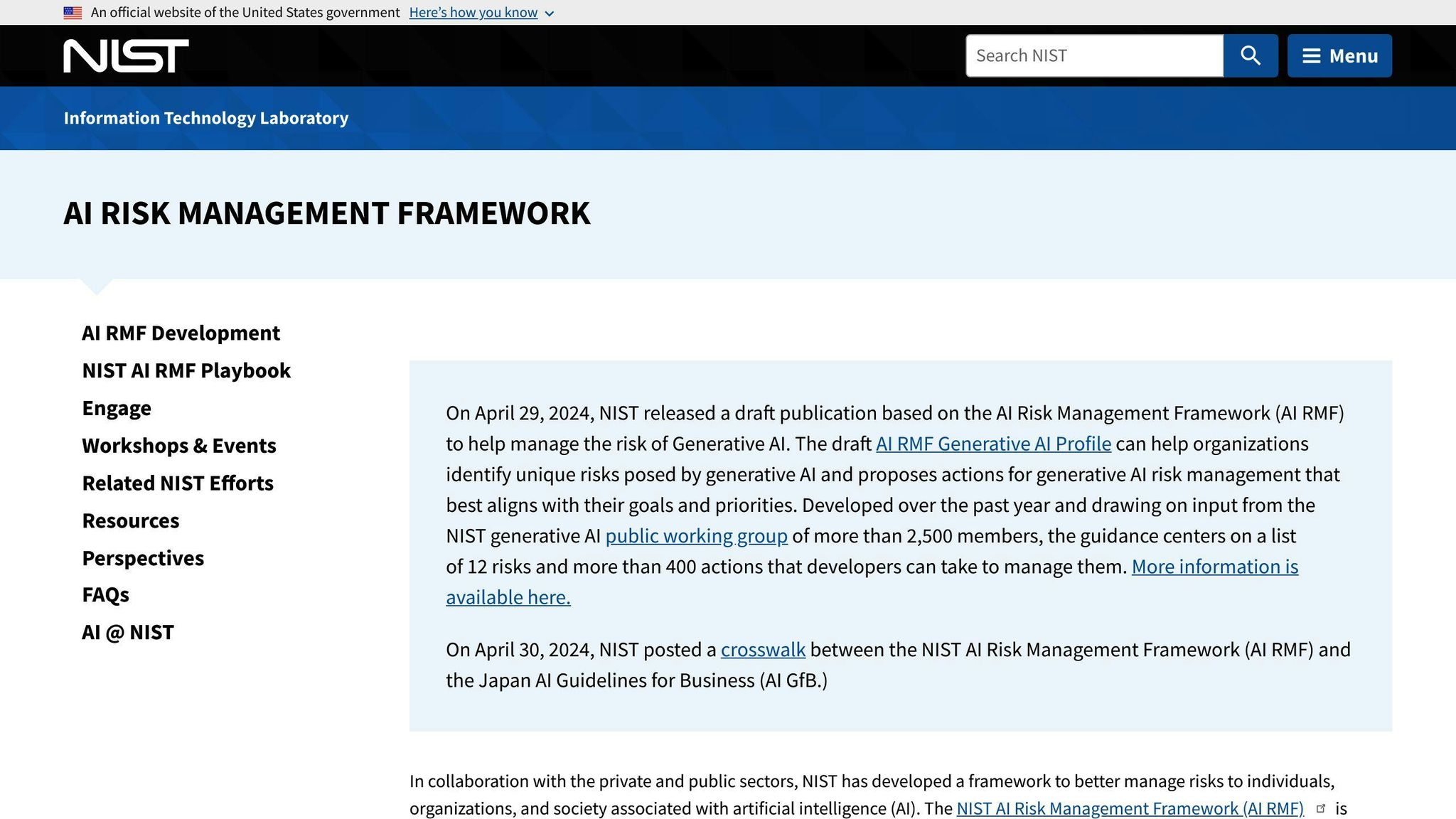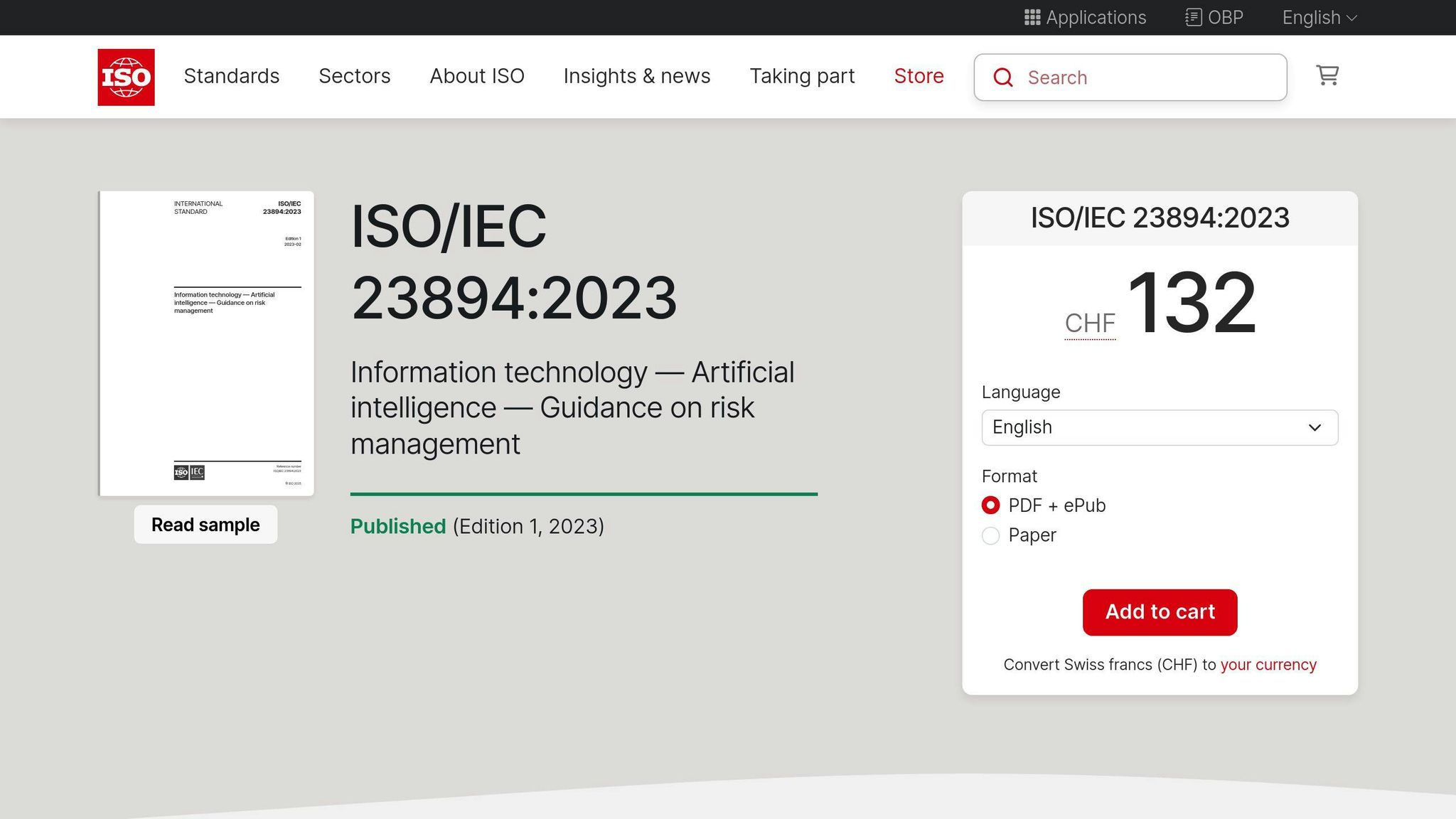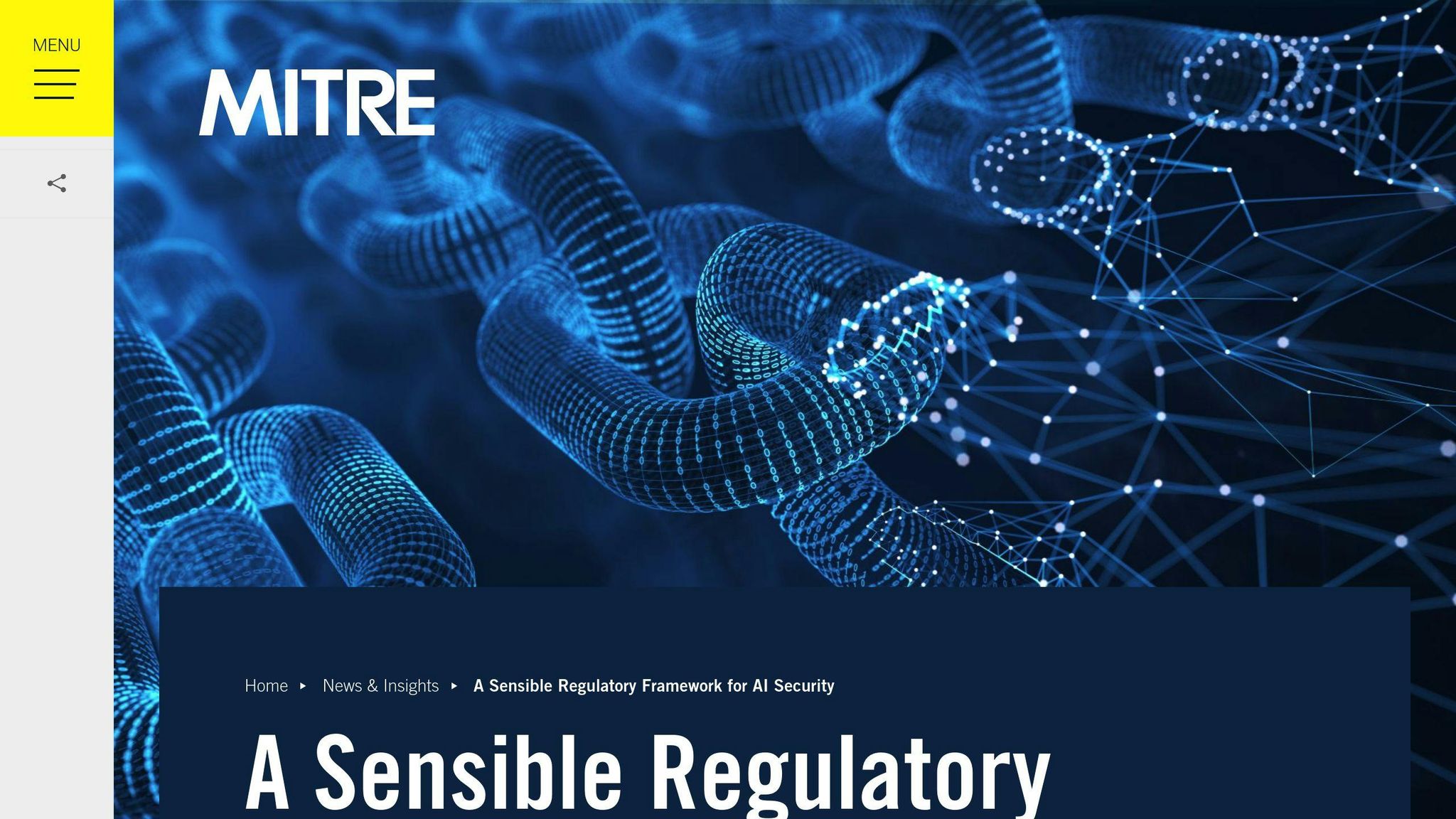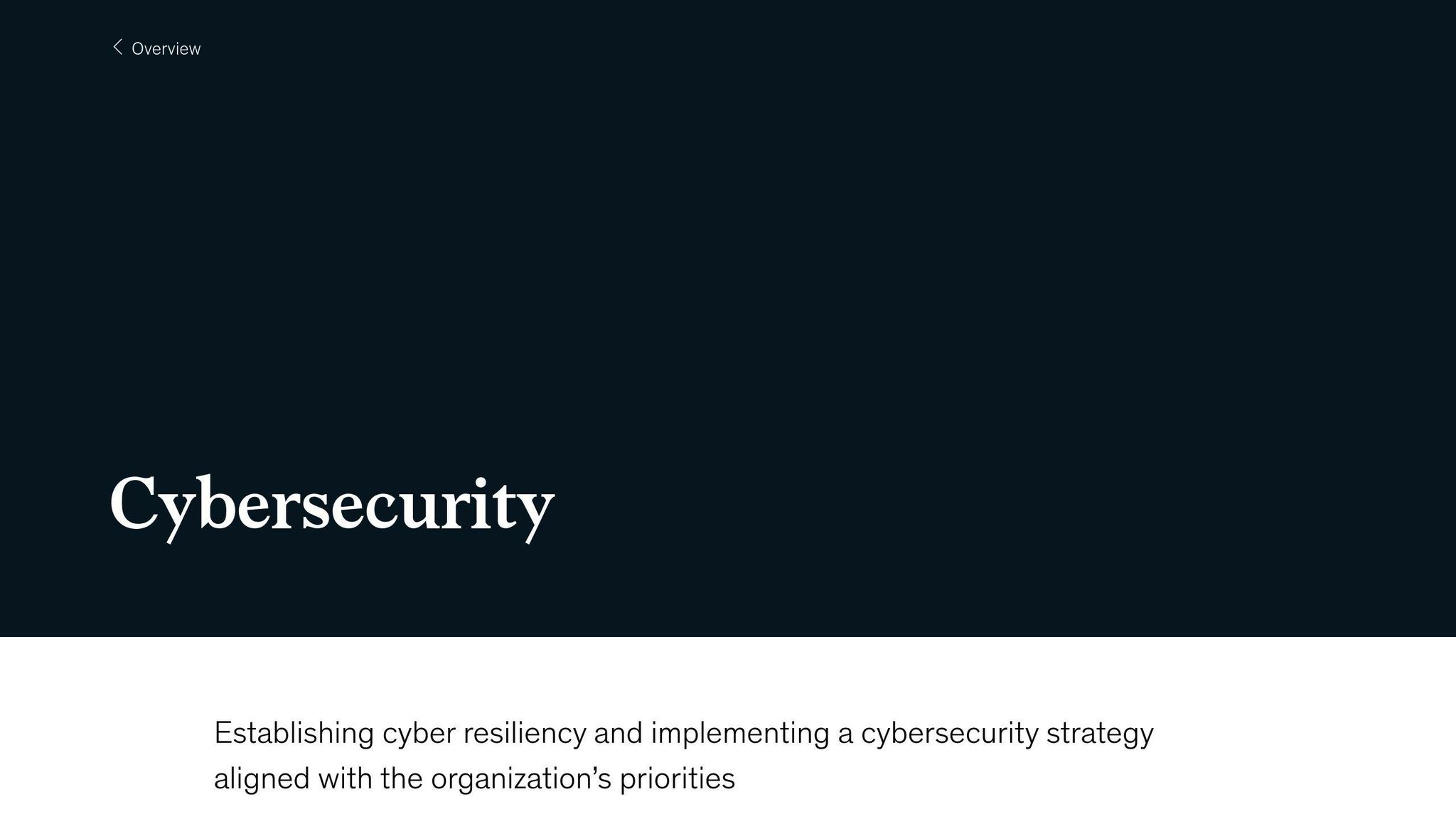Top 5 AI Risk Frameworks for SMBs

AI can boost your business, but it comes with risks like data breaches, algorithm bias, and compliance challenges. For small and medium-sized businesses (SMBs), managing these risks is critical but often overwhelming due to limited resources. Here’s a quick guide to five AI risk frameworks designed to help SMBs tackle these challenges:
- NIST AI RMF: Focuses on governance, risk mapping, measurement, and management. Ideal for SMBs seeking a flexible, scalable approach.
- ISO/IEC 23894:2023: A lifecycle-based framework for global compliance and transparency, suitable for businesses operating across multiple markets.
- MITRE's AI Security Framework: Targets technical security and regulatory alignment, perfect for highly regulated industries like healthcare and finance.
- Google's Secure AI Framework: Cloud-focused with built-in tools for secure AI development and data protection, tailored for SMBs using Google Cloud.
- McKinsey's AI Security Approach: Simplifies risk assessment and compliance, offering low-cost solutions that integrate with existing operations.
Quick Comparison
| Framework | Key Features | Complexity | Cost | Best For |
|---|---|---|---|---|
| NIST AI RMF | Governance, risk mapping, ongoing monitoring | Medium | Low | Cross-industry |
| ISO/IEC 23894:2023 | Lifecycle risk management, global compliance | High | Medium-High | Global operations |
| MITRE's Framework | Threat detection, regulatory alignment | High | Medium | Finance, Healthcare |
| Google's Secure AI | Cloud integration, real-time threat detection | Low | Low | Cloud-based businesses |
| McKinsey's Approach | Simplified tools, resource optimization | Low | Low | Cross-industry |
Pick a framework that fits your industry, resources, and goals. Start small, monitor progress, and adjust as your needs evolve. Managing AI risks doesn’t have to be overwhelming.
1. NIST AI Risk Management Framework (AI RMF)

The NIST AI RMF provides SMBs with a structured way to handle AI risks. It focuses on four main functions: Govern, Map, Measure, and Manage. This framework offers a step-by-step approach to help businesses address risks effectively.
For SMBs, this structure is especially helpful - it allows them to tackle AI risks without stretching their resources or expertise too thin. The framework is designed to work across various industries and align with different legal requirements.
Here’s a quick breakdown of the framework's core functions and their benefits:
| Function | Purpose | SMB Benefit |
|---|---|---|
| Govern | Sets up oversight and accountability | Defines roles and responsibilities clearly |
| Map | Identifies and documents AI risks | Creates a systematic way to spot risks |
| Measure | Evaluates and prioritizes risks | Makes risk assessment more resource-efficient |
| Manage | Puts risk mitigation strategies into action | Provides clear steps for controlling risks |
This structure helps SMBs handle AI risks in an organized way while tailoring the approach to their specific industry. Businesses can adopt the framework gradually, minimizing disruptions and ensuring steady progress. It’s versatile enough to work for industries ranging from healthcare to customer service.
The framework also emphasizes ongoing monitoring and improvement, helping SMBs adapt to new risks and regulatory changes. While it does take some effort to understand and set up initially, the framework’s clear structure helps businesses avoid costly errors and compliance challenges.
For those seeking more specialized guidance, frameworks like ISO/IEC 23894:2023 offer additional standards for AI risk management.
2. ISO/IEC 23894:2023

ISO/IEC 23894:2023 is a global standard designed to help small and medium-sized businesses (SMBs) manage AI-related risks throughout an AI system's lifecycle. What sets it apart is its focus on risk management from start to finish, ensuring businesses stay compliant across different markets and industries.
The framework is built around three core components that make it especially practical for SMBs:
| Component | Purpose | Business Impact |
|---|---|---|
| Risk Assessment | Identifies AI-related risks systematically | Targets risks specific to each stage of the AI lifecycle |
| Mitigation Strategies | Provides actionable steps to address risks | Helps businesses allocate resources effectively |
| Continuous Monitoring | Tracks AI system performance over time | Maintains system efficiency and adapts to changes |
The framework's clear and straightforward structure allows SMBs to integrate it into their existing workflows without disrupting operations. It’s particularly useful in sectors like healthcare, finance, and technology, offering tailored guidance to meet industry-specific compliance requirements.
Transparency is another key feature. Detailed documentation ensures SMBs can demonstrate compliance to regulators and stakeholders, building trust and accountability. For businesses looking to strengthen their implementation, AI security posture management (AI-SPM) tools can be used. These tools provide visibility through AI bills of materials (AI-BOM) and support proactive risk management.
The framework’s global relevance also helps SMBs align their AI systems with internationally accepted practices, keeping pace with changing regulations around the world.
While ISO/IEC 23894:2023 is a strong choice for SMBs, those focusing on security may also explore other frameworks like MITRE's Sensible Regulatory Framework for AI Security for additional insights.
3. MITRE's Sensible Regulatory Framework for AI Security

MITRE has developed a framework that blends technical security measures with regulatory compliance, making it especially useful for small and medium-sized businesses (SMBs) in industries like healthcare and finance, where regulations are strict. This approach provides SMBs with a structured way to manage AI-related risks while staying compliant.
The framework focuses on three main areas:
| Focus Area | Purpose | Business Benefits |
|---|---|---|
| Threat Detection | Identifies AI-specific attack vectors and risks | Helps businesses take preventive security actions |
| Regulatory Mapping | Aligns security efforts with compliance needs | Minimizes compliance risks and gaps |
| Shadow AI Management | Tracks and controls unauthorized AI usage | Reduces risks from unmonitored AI deployments |
For SMBs integrating AI systems, the framework offers practical tools to assess and reduce risks. It provides straightforward guidelines on data privacy and AI model transparency, helping businesses build customer trust while meeting compliance standards.
One standout feature is its AI-BOM tools, which deliver detailed insights into the components of AI systems. These tools help businesses maintain control and address potential risks effectively, ensuring a strong foundation for managing AI security.
MITRE's framework encourages businesses to prioritize critical risks, allowing SMBs to optimize their limited resources. This targeted approach ensures that essential security measures are implemented without overextending budgets or capabilities.
Although MITRE's framework focuses heavily on technical security and compliance, other frameworks, such as Google's Secure AI Framework, offer additional perspectives on managing AI risks effectively.
sbb-itb-ef0082b
4. Google's Secure AI Framework
Google's Secure AI Framework is built around six core elements aimed at secure development, data protection, and threat detection. It offers practical solutions for SMBs using Google Cloud services, especially in tackling challenges like data security and compliance.
The framework focuses on three main areas:
| Focus Area | Key Features | SMB Benefits |
|---|---|---|
| Secure Development | AI pipeline security protocols, code validation | Lowers risks in AI implementation processes |
| Data Protection | GDPR and CCPA compliance, data encryption | Keeps data safe and meets regulatory standards |
| Threat Detection | Real-time monitoring, automated responses | Helps manage risks proactively |
This framework is designed to work seamlessly with Google Cloud services, making it easier and more cost-effective to implement. Its compliance controls - aligned with GDPR and CCPA - help protect data without requiring extra tools. Plus, step-by-step resources guide businesses to adopt these measures at their own pace.
A key focus is on securing AI pipelines, ensuring businesses build safe environments for model development and deployment. By addressing security early in the process, companies can avoid potential issues down the line.
For SMBs, the framework's integration with cloud services provides practical, budget-friendly security solutions. Built-in tools and automation make it easier to maintain strong security practices, even with limited resources. As businesses grow, the framework scales alongside them, leveraging Google Cloud's infrastructure to expand security efforts.
While Google's Secure AI Framework zeroes in on secure AI development and deployment, McKinsey's AI Security Approach offers a broader perspective on risk management strategies.
5. McKinsey's AI Security Approach

McKinsey's AI Security Approach provides a practical framework tailored for small and medium-sized businesses (SMBs). It aims to balance AI-driven opportunities with effective risk management. The framework is built around three main focus areas that cater to the specific needs and limitations of SMBs:
| Dimension | Key Features | Business Impact |
|---|---|---|
| Risk Identification | Tools and metrics for SMB operations | Helps pinpoint and prioritize critical risks |
| Regulatory Alignment | Customized compliance strategies | Ensures legal requirements are met effectively |
| Operational Integration | Implementation with existing resources | Optimizes current capabilities without causing disruption |
This framework is especially helpful for SMBs that may lack advanced technical expertise. It seamlessly integrates with ongoing operations, requiring minimal additional investment - a key benefit for businesses operating on tight budgets.
McKinsey's strategy focuses on real-world application through:
- Simplified risk assessment tools
- Compliance guidelines tailored to specific industries
- Cost-efficient monitoring systems
To measure success, the framework relies on key performance indicators (KPIs) such as the number of AI-related incidents and compliance violations. These metrics help businesses identify weak points and improve processes while maintaining efficiency.
This approach is particularly effective in highly regulated sectors like finance and healthcare, where protecting sensitive data and ensuring AI transparency are critical. It offers clear steps for implementing controls that safeguard information and build trust with stakeholders.
Comparison Table
Here's a quick look at how these frameworks stack up for SMBs across important factors:
| Framework | Core Features | Implementation Complexity | Cost Considerations | Industry Focus | SMB Suitability Score (1-5) |
|---|---|---|---|---|---|
| NIST AI RMF | • Govern, Map, Measure, Manage functions • Role-based implementation • Comprehensive risk assessment |
Medium | Low to Medium | Cross-industry | 4 |
| ISO/IEC 23894:2023 | • Lifecycle-based approach • Global compliance support • Transparent AI practices |
High | Medium to High | Global operations | 3 |
| MITRE's Framework | • Detailed threat models • Technical risk analysis • Regulatory recommendations |
High | Medium | Finance, Healthcare | 3 |
| Google's Secure AI | • Six core safety elements • Cloud integration • Built-in threat detection |
Low | Low | Technology, Cloud-based | 5 |
| McKinsey's Approach | • Risk identification tools • Industry-specific compliance • Resource optimization |
Low | Low | Cross-industry | 5 |
For SMBs, choosing the right framework is all about matching their operational needs and growth plans. Here's what stands out:
- Ease of Implementation: Google's Secure AI and McKinsey's approach are both affordable and quick to deploy, making them great options for SMBs looking for fast yet effective solutions.
- Industry Fit: MITRE's framework is ideal for sectors like finance and healthcare, where regulation is a top priority. Meanwhile, ISO/IEC 23894:2023 is better suited for businesses with global operations.
- Efficient Resource Use: NIST AI RMF provides a flexible approach that's easy to scale as SMBs grow.
Each framework has its strengths, so SMBs should focus on what aligns best with their specific goals and challenges.
Wrapping Up
For SMBs, having a solid risk framework in place is now essential. These frameworks help businesses adopt AI responsibly while minimizing potential risks.
The good news? SMBs don’t need massive budgets or deep technical expertise to put effective AI governance into action. For industries like healthcare or finance, options like MITRE's framework can help meet compliance requirements and tackle sector-specific issues.
Managing AI risks isn’t a set-it-and-forget-it task. Regular reviews are key to keeping up with changing technology and regulations, ensuring your framework works for both today and tomorrow.
Start by pinpointing your AI-related risks and challenges. Whether you go with NIST, Google, or another option, make proactive risk management your top priority.
Summarize with AI
Related Posts
Edge AI Security Checklist for SMBs
Secure your edge AI systems with essential strategies like Zero Trust networking, encryption, and AI-driven threat detection tailored for SMBs.
AI in Cybersecurity 2024: Benefits, Risks, Best Practices
Discover the benefits, risks, best practices, and industry trends of using AI in cybersecurity in 2024. Stay ahead of cyber threats with AI-powered solutions.
AI Risk Management: Best Practices
Learn essential strategies for managing AI risks, from data safety checks to continuous improvement, to ensure compliance and security.
10 AI Security Standards & Best Practices 2024
Explore the top 10 AI security standards and best practices for 2024. Learn how to secure AI systems, protect sensitive data, and maintain customer trust.
